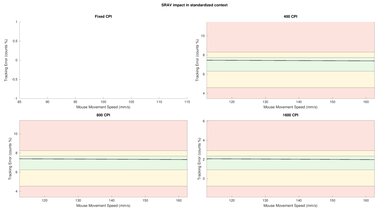The Razer Basilisk X Hyperspeed is a fairly well-rounded mouse that's versatile enough for a variety of uses. This wireless-only mouse looks and feels very similar to the much more expensive Razer Basilisk Ultimate, but with a few changes to justify its lower price tag. It has no RGB lighting and is powered by a single AA battery instead of charging via USB. This means that there's no plug for it at all, and it can't be used wired. It also lacks the sniper button that the Basilisk series is known for, which is unfortunate.
Our Verdict
The Razer Basilisk X Hyperspeed is a surprisingly great mouse for office use. While it has a somewhat gamer-centric look, its lack of RGB lighting and flashy design elements means it will fit in well with most setups. It has an ergonomic right-handed shape with a thumb-rest, making it great for using all day. Its two additional buttons can be reprogrammed, along with its L/R and scroll wheel, so you can set shortcuts to help you navigate your desktop or work software quickly.
- Good price to performance ratio.
- Premium and well-built design.
- Suitable for almost every hand size with every grip type.
- Superb click latency.
- Unreliable CPI adjustments.
- Quite heavy.
Unfortunately, the Razer Basilisk X Hyperspeed is only decent for FPS games as it's quite heavy, and you won't be able to react as quickly with it in-game. That said, it has extremely low click latency and an ergonomic shape that's well-suited to all grip types and most hand sizes.
- Good price to performance ratio.
- Premium and well-built design.
- Suitable for almost every hand size with every grip type.
- Superb click latency.
- Unreliable CPI adjustments.
- Quite heavy.
The Razer Basilisk X Hyperspeed is a very good mouse for MMO games. While it doesn't have nearly as many buttons as a dedicated MMO mouse, every button that this mouse does have can be reprogrammed. It's also quite comfortable with any grip by any size of hand, except for fingertip with very small hands. Unfortunately, although it has on-board memory, you can't save any macros onto it.
- Good price to performance ratio.
- Premium and well-built design.
- Suitable for almost every hand size with every grip type.
- Superb click latency.
- Unreliable CPI adjustments.
- Quite heavy.
- Good price to performance ratio.
- Premium and well-built design.
- Suitable for almost every hand size with every grip type.
- Superb click latency.
- Unreliable CPI adjustments.
- Quite heavy.
Changelog
- Updated Aug 19, 2025: We've converted this review to Test Bench 1.5.1. This update removes less relevant or redundant elements, including several videos. We've also adjusted our Sensor Latency testing, resulting in minor score changes. See our full 1.5.1 changelog for details.
- Updated Jan 05, 2024: We've updated the CPI graph displayed in the Sensor Latency section of this review. Our results remain the same, but these graphs have two new columns with results from the Delay At Half Movement and Delay To End Of Movement tests.
- Updated Nov 24, 2023: We've converted this review to Test Bench 1.5. This update adds a new Main Button test group, which provides button actuation data and switch information. We've also made minor changes to how we calculate the Office usage score. For more details, you can see our full changelog here.
- Updated Feb 24, 2023: We've converted this review to Test Bench 1.4. This update modifies our Hand Size Recommendation test, adding a more granular hand size recommendation chart. We've moved several minor tests into different test groups, removed the Travel usage, and added a new Raw Performance usage. For more details, you can see our full changelog here.
Check Price
Popular Mouse Comparisons
The Razer Basilisk X Hyperspeed is a cheaper version of the Razer Basilisk Ultimate, and a wireless version to the regular Razer Basilisk. Unlike its siblings, the Razer Basilisk X Hyperspeed doesn't have a sniper button, and unlike the more expensive version, it can't be used wired and is powered by a single AA battery. It's still a very capable mouse, however, especially for the price point. Check out our recommendations for the best gaming mouse, the best FPS mouse, and the overall best mouse.
The Logitech G502 LIGHTSPEED is a slightly better mouse than the Razer Basilisk X Hyperspeed. While these two mice have a very similar shape, the Logitech has a better sensor overall and more programmable buttons. It also has an unlockable wheel, and its software is fully compatible with macOS. On the other hand, the Razer is a wireless-only mouse that uses an AA battery and can't recharge. It also supports a Bluetooth connection, which the Logitech doesn't.
The Logitech G305 LIGHTSPEED and the Razer Basilisk X Hyperspeed are both good wireless gaming mice. The Logitech has an ambidextrous design and a slightly smaller body that’s more suitable for small and medium hands. If you’re planning to use your mouse with a different OS, it could be a better option since it’s fully compatible with both Windows and macOS. Its sensor is also more consistent, and it has a lower lift-off distance. On the other hand, the Razer has a wider CPI range and more programmable inputs with the option to set a Hypershift button. Shape-wise, the Razer should fit more hand sizes with any grip type.
The Razer Basilisk V3 is a newer, wired iteration in the Basilisk lineup, while the Razer Basilisk X Hyperspeed is an older, wireless iteration. The Basilisk V3 is a wired-only model that's lighter and has better quality mouse feet. It also has five additional buttons, including an extra side button, and it has RGB lighting, which the Basilisk X Hyperspeed lacks. Performance-wise, it has a higher maximum CPI, a lower lift-off distance, and lower click latency. It also has a scroll wheel with L/R tilt buttons and a free-scrolling mode. On the other hand, the Basilisk X Hyperspeed connects wirelessly with its USB receiver or via Bluetooth.
The Logitech G502 HERO is a better gaming mouse than the Razer Basilisk X Hyperspeed. The Logitech has more programmable buttons, a much more consistent sensor, and a better mouse wheel with L/R tilts, and a button to unlock free scrolling. It also uses Logitech's G HUB, which is compatible with both Windows and macOS. The Razer is wireless and has the same click latency as the wired Logitech. The Razer is also more suitable for people with small hands in both palm and claw grip.
Test Results

The Razer Basilisk X Hyperspeed looks basically identical to the Razer Basilisk Ultimate, except with no RGB lighting. It also doesn't feature the sniper button on the left side of the mouse. It has the same right-handed ergonomic design with a thumb rest.
The Razer Basilisk X Hyperspeed's build quality is excellent, and it feels the same as the much more expensive Razer Basilisk Ultimate, which is great. The main difference between the two is that the Ultimate has better quality feet, though this may not be a huge deal to everyone. The only wobble you hear when you shake the mouse is from the battery, though this isn't noticeable in regular use.
The Razer Basilisk X Hyperspeed is fairly heavy. The Default Weight result includes an AA Amazon rechargeable battery which weighs 15.10g. The Lowest Weight result is obtained using an aluminum foil ball adapter to allow for the use of AAA batteries. The aluminum foil ball used to obtain this result has a reference weight of 0.2g and a diameter of 5.8mm. The AAA battery used is an Energizer Ultimate Lithium battery with a reference weight of 7.60g.
The Razer Basilisk X Hyperspeed is a wireless-only mouse than can be used via Bluetooth or with its included USB receiver. Unfortunately, it doesn't have a rechargeable battery built-in and uses a single AA battery. Razer claims a single AA battery will last 450 hours on Bluetooth, or 285 hours when using the USB receiver, though we don't currently test this.
The Razer Basilisk X Hyperspeed is a wireless-only mouse that cannot be plugged in.
The Razer Basilisk X Hyperspeed has six buttons, all of which are programmable, including the up and down scroll on the mouse wheel. You can also assign a HyperShift button to give a second layer of programmed buttons.
The Razer Basilisk X Hyperspeed has superb click latency when connected with its USB receiver. The click latency is noticeably higher and less consistent when connected via Bluetooth. However, this is normal, and a Bluetooth connection isn't recommended for reaction-based gaming.
The mouse wheel on the Razer Basilisk X Hyperspeed is mediocre. While the scroll itself is quite clicky, unlike the regular Razer Basilisk or the Razer Basilisk Ultimate, there is no scroll adjustment slider on the bottom of the mouse to change this, which is a shame. A full scroll of the mouse wheel from front to back will result in around 10 or 11 clicks.
Update 11/23/2020: We previously indicated that there's no on-board memory, which is wrong. It has been corrected.
This mouse is compatible with Razer Synapse 3, which is a great piece of software. It has onboard memory, which allows you to access your custom profiles on other computers that don't have Synapse 3 installed. However, you can only save the sensitivity settings and remapped keyboard/mouse functions, not macros.
Since Razer Synapse 3 is only compatible with Windows, you can only customize it on a Windows computer. If you want to access your custom profiles on a Mac, you need to customize the mouse first on a Windows computer and save the settings onto the the on-board memory.












